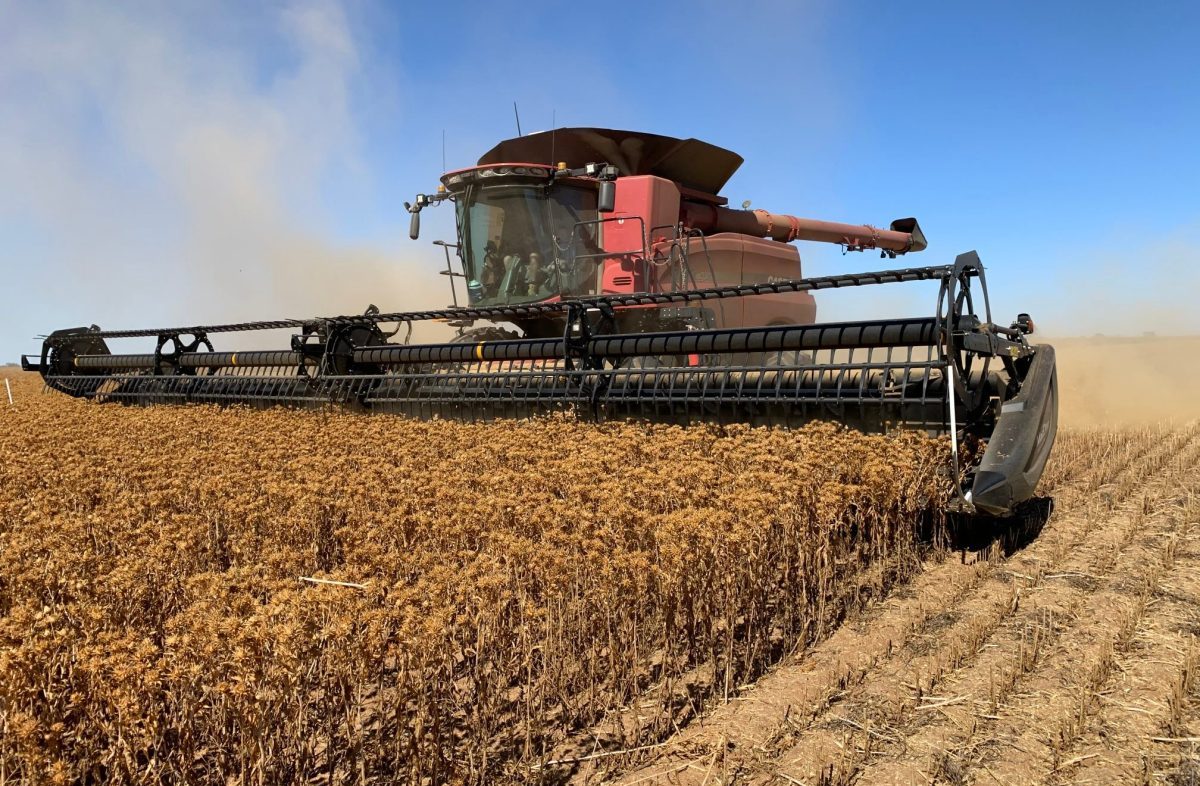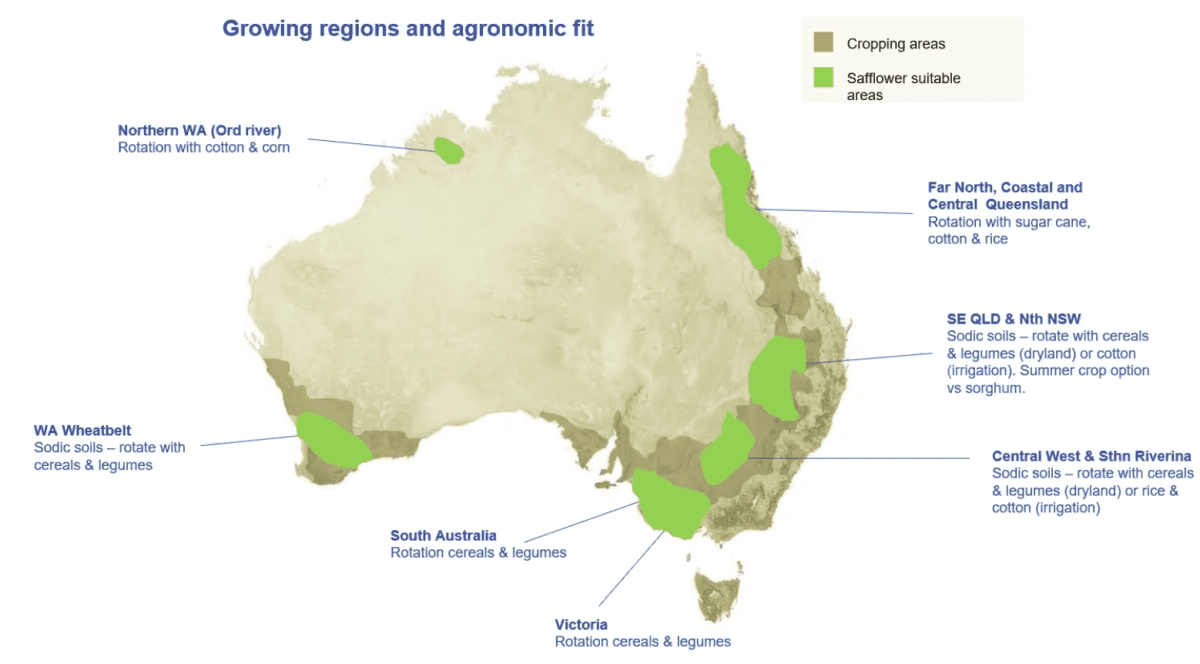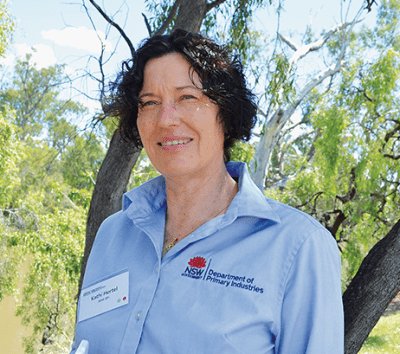
Photo: Delta Agribusiness
AN ALMOST 20-year project to develop a new more sustainable and environmentally friendly plant-based industrial oil is reaping the rewards with the demand for Super-High Oleic (SHO) safflower oil currently out-stripping supply, according to product licensee Go Resources.
The project, originally called the Crop Biofactories Initiative, was led by the CSIRO and the Grains Research and Development Corporation (GRDC) with the aim of using gene technology to produce a safflower variety with higher levels of oleic acid.
Researchers were successful in increasing the oleic acid level in safflower oil from the 17 per cent in traditional varieties to the 91-93pc found in the SHO lines.
Oils with high levels of oleic acid are used in industrial oils such as lubricants and biodiesel, for human consumption, and in personal-care products.
Go Resources, which signed an agreement to commercialise the crop in 2015, is currently selling the oil mostly to the industrial and agricultural oils sector domestically and overseas.
Go Resources R & D lead David Hudson told a GRDC market update webinar last week that interest in SHO safflower oil was growing.
“The future for SOH safflower is bright; the market is strong for the product,” Mr Hudson said.
“Certainly, the events globally for the last 12 months, particularly in Europe with the Ukrainian war where there has been a shortage of oleic sunflower oil, has led to an increase in awareness and customers coming to Go Resources and setting up longer-term contracts.”
Mr Hudson said the current aim was to promote this product to higher-value BioLiquid formulation and transformer oil markets, rather than concentrating on “high-volume, low-value” food oils or biodiesels.
“For example, we have got a company in India that we have signed a five-year supply agreement with who are one of the world’s largest lubricant manufacturers.
“We have product going into Europe to various customers and also too we got a lot of interest out of the US from people in the old ag-chemical industry.
“The key at the moment is that the demand from some of these customers outstrips what our current production is.
“We have already seen, with the interest out of the US for example, that their initial order is many, many more thousands of hectares than what we are growing at the moment.”

Recent research in NSW had safflowers sown from May to October and harvested from December to February. Photo: Delta Agribusiness
Improving supply chains
Mr Hudson said the company was now working with growers and crushers to expand the safflower crop and oil production.
He said currently the crop is grown in New South Wales, Victoria and Western Australia, with seed transported to crushers in southern NSW.
He said the company mostly arranged freight off-farm for growers to select delivery points.
“From the point of view of logistics post farm gate at the moment we are being targeted in key areas.
“We have established as the last two or three years have expanded…delivery points.
“At the moment we have got them in northern NSW, we have got them in Victoria and southern NSW.”
Mr Hudson said was done to create the most efficient and cost-effective path to crushers.
He said to use the main facilities, the company needed to reach volume thresholds.
“Some of the major crushers you have to get over that threshold volume to make it economically worthwhile for them putting it through the plant because they’ve got to do cleandowns between each of the oils.
“At the moment, the crushing is being done regionally, with a couple of the key crushers in southern NSW and at the moment that is meeting the demand we have got.
“We are setting up crushing arrangements in Western Australia and we are also looking constantly at what other innovations we could make to crushing, given that it is a threshold crop and it’s a new crop.”
Micro-crushing possibilities
Mr Hudson said Go Resources was actively researching the viability of setting up micro-crushing plants in key safflower-growing areas which would only process the new crop.
He said places like Geraldton in WA were high on the list for possible locations.
“[This] would be establishing regional micro-crushing plants where you can actually crush it in reasonable quantities in the region, and all your transport is the oil rather than the grain.”
Mr Hudson said a possible plant would require a certain annual volume to be viable.
He said early investigations show a plant would need to process about 5000 tonnes annually.
He said on current yields, that would mean about 15,000 hectares of safflower would need to be planted in a 200-300 kilometre radius for a micro-crusher to be justifiable.
According to research over the past three years in NSW, safflower crops have yielded 0.28-2.28t per hectare.
Mr Hudson said currently growers are getting about $750/t for safflowers, up from $650/t in 2019.

Crop growing regions which would be suited to growing safflowers. Photo: Go Resources
New varieties on horizon
Investment from CSIRO, GRDC, Go Resources and Victorian Department of Agriculture has resulted in more safflower varieties being offered or soon to become available to growers.
Mr Hudson said this work has accelerated the development of safflowers which, before this investment, had not had any plant breeding activities for about 25 years and had “very limited” varieties available.
“Now we are at the stage where we are about to release our second and third generation varieties which will see two new varieties in 2023 and future varieties coming out sequentially after that.
“We are aiming to significantly ramp up the regionally adapted varieties across the Australian environment.”
More research, education required
Mr Hudson said current research has shown more agronomy work needed to be done as well as educating growers and their advisors.
He said gaps in research included time of sowing, seeding rates and herbicide usage.
This view was backed by NSW Department of Primary Industries researcher Kathi Hertel who has been researching the SHO safflower crop for several seasons.
Ms Hertel told the GRDC webinar that overall understanding of the crop in the NSW growing regions was low, but the impression from growers who trialed the variety was positive.

NSW DPi researcher Kathi Hertel.
“Knowledge of the crop…is quite low and a lot of advisors had minimal…experience with it,” Ms Hertel said.
“Safflower hasn’t been grown extensively for many years; this is a whole new industry and it’s not the old traditional safflower that was grown.”
She said most growers were enthusiastic about the crop, despite it not performing as well as predicted.
“Talking to growers, some said that it was an exciting crop to grow.
“Yes, it hasn’t perhaps met my expectations, but they see it as an industry going forward as something they want to get involved with and included in their current rotations.”
Ms Hertel attributed much of the yield and plant-establishment issues experienced by the NSW growers to the recent wet seasons.
She said the crop, known to be drought and heat tolerant, did not perform well in the very wet conditions.
She said this issue, as well as others, will be the focus on future result programs.
Grain Central: Get our free news straight to your inbox – Click here

HAVE YOUR SAY